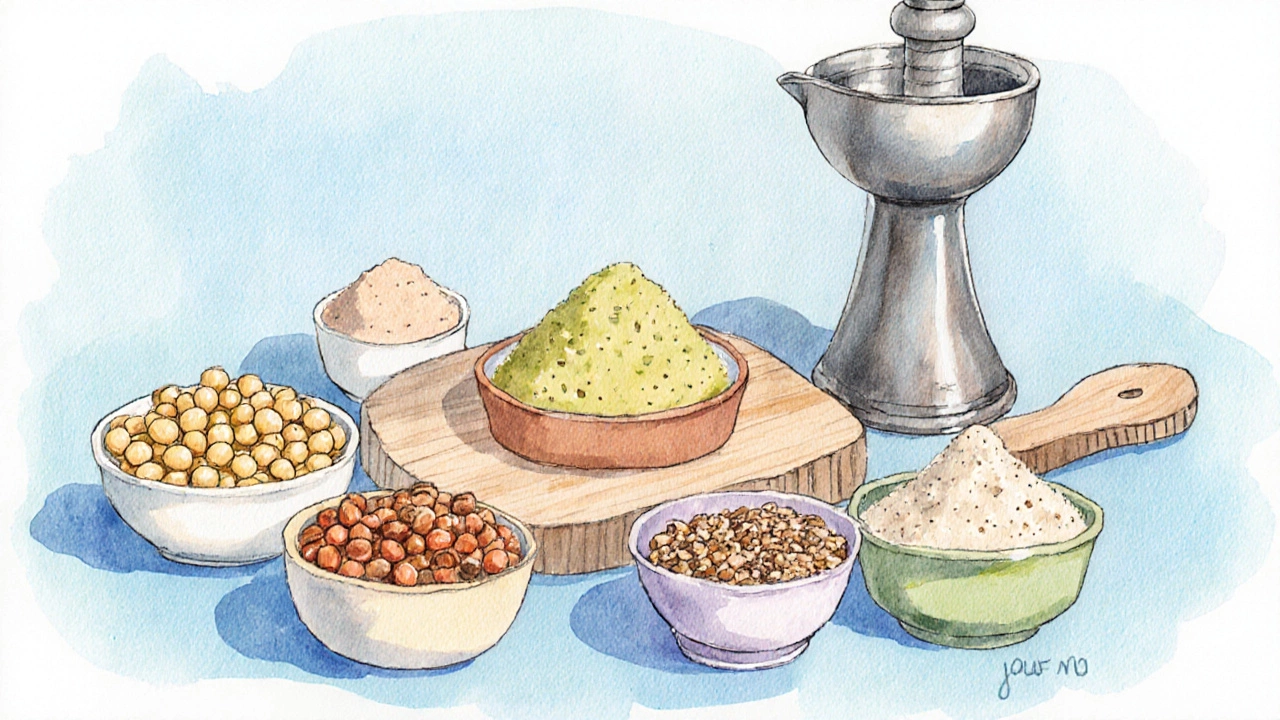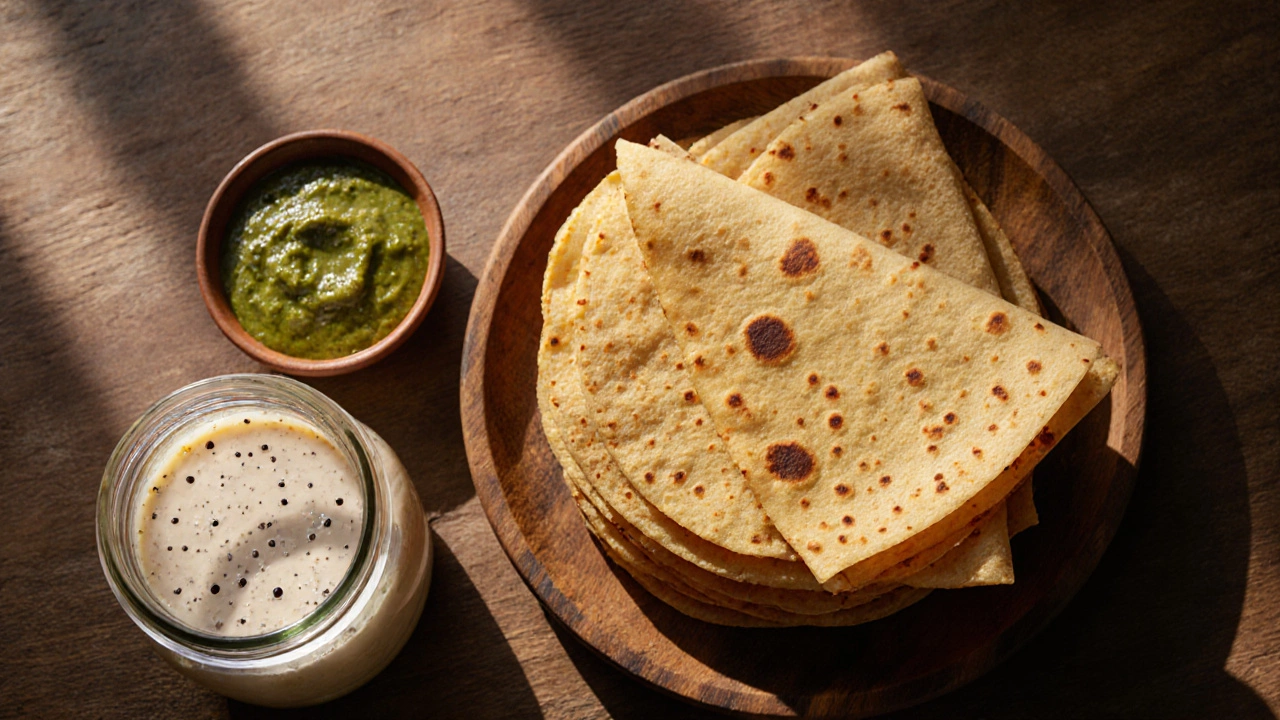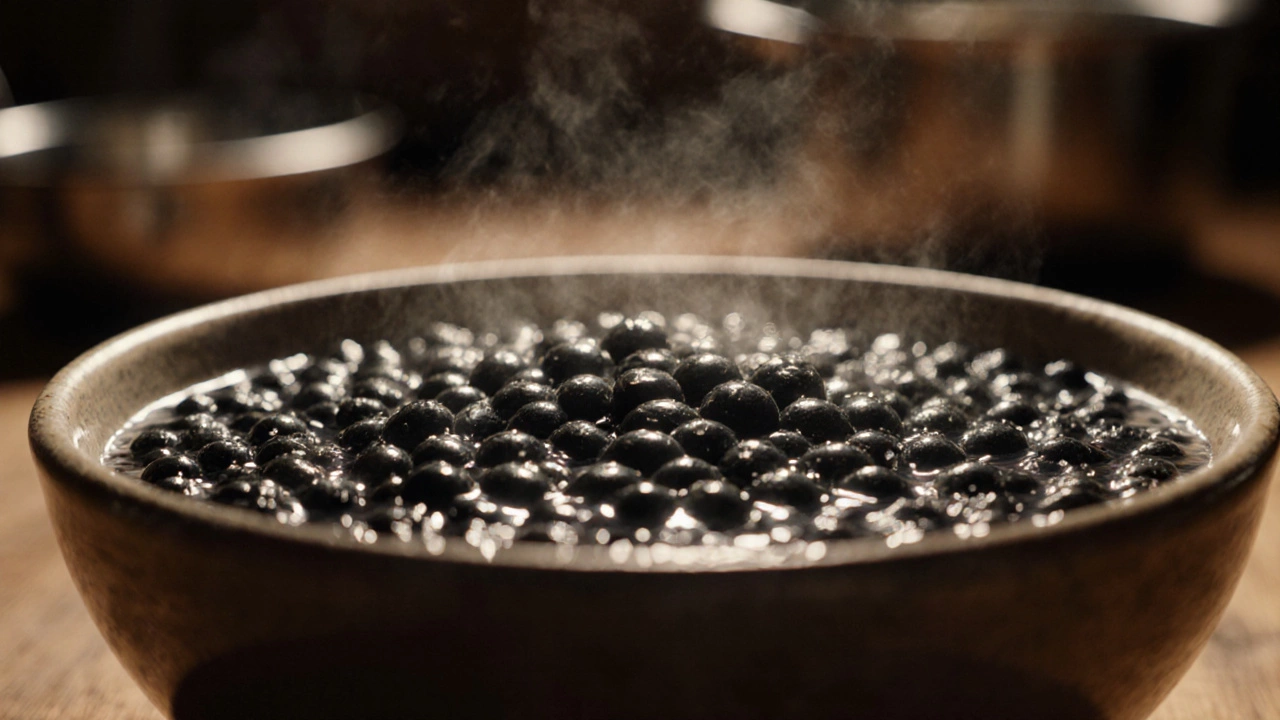Urad Dal Substitute Calculator
Recommended Substitute
Substitute Comparison
Key Takeaways
- Urad dal provides protein, fermentable sugars, and a soft texture; any substitute must cover these three jobs.
- Chickpeas, soybeans, moong dal, lentils, rice, and quinoa are the most reliable alternatives.
- Soak the chosen legume for 4‑8hours, grind to a fine paste, and add the same amount of rice flour for balance.
- Fermentation time drops to 6‑10hours with high‑protein beans; warm the batter to 30‑35°C for best results.
- Adjust water to achieve a batter consistency like pancake milk; too thick leads to dense dosas, too thin yields crispy but fragile sheets.
When you hear Urad dal is a black gram lentil commonly used in South Indian cooking, you probably picture that signature light‑and‑crisp dosa. But if you run out of the bean, are allergic, or follow a vegan diet that avoids legumes with strong flavors, you’ll need a good urad dal substitute. Below we break down why urad dal matters, what to look for in a replacement, and how to turn the most popular alternatives into a batter that ferments beautifully.
Why Urad Dal is the Star of Dosa Batter
Three reasons make urad dal the go‑to ingredient:
- Protein punch - It contributes roughly 20% protein, which feeds the natural yeasts during fermentation.
- Fermentable sugars - The bean’s starch breaks down into simple sugars, creating the mildly sour aroma we love.
- Silky texture - When ground, the beans become a glossy paste that traps air bubbles, giving dosas their airy bite.
If any substitute can mimic these traits, the result will be a dosa that’s almost indistinguishable from the original.
What Makes a Good Replacement?
Look for the following attributes:
- High protein content (15‑25% dry weight) to sustain fermentation.
- Neutral or mildly sweet flavor so it doesn’t overpower the rice.
- Fine grindability - the bean should produce a smooth paste without grit.
- Short soaking time - for busy cooks, a bean that softens in 4‑6hours is ideal.

Top 7 Urad Dal Substitutes
Each option below includes the bean’s key stats, how to prep it, and the taste profile you can expect.
Chickpeas (Cicer arietinum, a pale yellow legume), also known as garbanzo beans, pack about 19% protein and a subtle nutty note. Soak them for 6‑8hours, grind with a little water, and mix with an equal part of rice flour. The batter ferments quickly and yields a slightly denser dosa that’s perfect for stuffing.
Soybeans (Glycine max, a high‑protein bean) are the strongest protein source (≈36%). After a 4‑hour soak, blend into a smooth puree and thin it with water to match the consistency of urad dal paste. Fermentation may finish in 6‑8hours, producing dosas with a faint earthy undertone.
Moong dal (Yellow split gram, low‑fat legume) offers 24% protein and a sweet, mild flavor. Soak for 4‑5hours, discard the skins if you prefer extra smoothness, then grind. The resulting dosa is light and airy, very close to the traditional version.
Lentils (Various Lens culinaris varieties) such as red or brown lentils give 25% protein. Because they contain more fiber, a 5‑hour soak and an extra splash of water during grinding help keep the batter from getting gritty.
Rice (Oryza sativa, gluten‑free grain) on its own lacks protein, but when paired with a high‑protein bean (like soy or chickpeas) it balances flavor and texture. Use parboiled or idli rice for a smoother grind.
Quinoa (Chenopodium quinoa, a pseudo‑grain) supplies complete protein (≈14%). Rinse well, soak for 2‑3hours, then blend with rice flour. The batter has a slight crunch and a nutty aroma, excellent for fusion dosas.
Besan (Chickpea Flour) (Finely milled chickpea powder) can replace the soaked bean entirely if you’re in a hurry. Mix 1cup besan with 1cup rice flour, add 1½cups water, and let sit for 4‑5hours. The dosa will be crispier and have a distinctive golden hue.
Step‑By‑Step: Making Dosa Batter with Each Substitute
Below is a universal method; just swap the bean in step2.
- Measure the base. Use a 1:1 ratio of rice (or rice flour) to the chosen legume. For example, 200g rice+200g chickpeas.
- Soak. Place the legume in water at room temperature. Soaking times vary (see the table below). Add a pinch of salt to aid softening.
- Rinse and drain. Discard the soaking water, rinse the beans thoroughly to remove anti‑nutrients.
- Grind. Using a wet grinder or high‑speed blender, blend the beans with enough fresh water to form a smooth paste-about 1½cups water for 200g beans.
- Combine with rice. Add the pre‑soaked rice (or rice flour) to the bean paste. Blend again until the mixture is uniform and slightly frothy.
- Season. Stir in ½tsp fenugreek seeds (optional, boosts fermentation) and a pinch of salt.
- Ferment. Transfer the batter to a wide‑mouth container, cover loosely, and keep at 30‑35°C for 6‑12hours. Bubbles should appear on the surface, and the batter will increase in volume.
- Adjust consistency. Before cooking, thin the batter with a little water to the consistency of heavy cream. It should pour easily but coat the pan without running off.
- Cook dosas. Heat a non‑stick or cast‑iron skillet, drizzle a few drops of oil, pour a ladle of batter, spread thin, and cook until golden spots appear. Flip if you like extra crispness, then serve hot.
Mixing Ratios and Fermentation Hacks
Here are a few proven tweaks:
- Add a dash of yogurt (½cup) when fermenting soy‑based batter; it supplies extra lactic bacteria.
- Use a warm oven (just the light on) to maintain temperature on cooler days.
- Blend a small portion of the batter with a teaspoon of sugar if fermentation is sluggish-sugar feeds the microbes.
- Replace part of the rice with millet (e.g., foxtail or finger millet) for a more nutritious dosa without changing the texture drastically.

Comparison of Popular Urad Dal Alternatives
| Alternative | Protein (% dry) | Soak Time (hrs) | Flavor | Best For |
|---|---|---|---|---|
| Chickpeas | 19 | 6‑8 | Nutty, mild | Stuffed dosas, thicker crepes |
| Soybeans | 36 | 4‑5 | Earthy | High‑protein vegan dosas |
| Moong dal | 24 | 4‑5 | Sweet, delicate | Traditional‑style airy dosas |
| Lentils | 25 | 5‑6 | Robust, slightly bitter | Hearty, nutrient‑dense dosas |
| Quinoa | 14 | 2‑3 | Nutty, crunchy | Fusion & gluten‑free dosas |
| Besan (dry) | 22 | 0 (no soak) | Rich, slightly bitter | Quick‑cook, crispy dosas |
Common Pitfalls and How to Fix Them
Grainy texture. Usually caused by under‑soaking or coarse grinding. Extend soaking by an hour and use a wet grinder for a silky paste.
Flat, non‑fermented batter. Check ambient temperature; below 25°C fermentation stalls. Warm the batter gently in a pre‑heated oven or place the container near a stove.
Too sour after fermentation. Reduce fermenting time or add a pinch of baking soda before cooking to neutralize excess acidity.
Dosas stick to the pan. Ensure the batter isn’t too thin and that the pan is well‑heated with a thin film of oil.
Putting It All Together: Sample Recipe Using Chickpeas
For a quick, urad‑free dosa, try this chickpea‑rice blend:
- 200g white rice (or parboiled rice) \n
- 200g dried chickpeas
- ½tsp fenugreek seeds (optional)
- ½tsp salt
- Water as needed (≈2cups for grinding, plus extra for consistency)
- Rinse rice and chickpeas separately; soak chickpeas for 7hours, rice for 4hours.
- Drain, rinse, then grind chickpeas with 1½cups water until smooth.
- Add soaked rice and blend together, aiming for a thick but pourable batter.
- Stir in fenugreek seeds and salt; cover and ferment 8‑10hours at 30°C.
- Before cooking, thin with ¼cup water if needed, then cook as usual.
The result is a golden, slightly nutty dosa that pairs perfectly with coconut chutney and tomato sambar.
Frequently Asked Questions
Can I use only rice without any legume?
Pure rice batter will make crispy crepes but lacks the protein and fermentation boost that legumes provide. You’ll end up with a plain rice pancake that doesn’t puff up. Adding at least 10% legume (by weight) is recommended for a true dosa texture.
Is soy safe for people with soy allergies?
No. Soybeans are a common allergen, so anyone with a soy allergy should avoid soy‑based substitutes and choose chickpeas, moong dal, or lentils instead.
How long can fermented batter be stored?
In the refrigerator, a well‑fermented batter stays good for 3‑4 days. For longer storage, freeze portions in airtight containers and thaw overnight before cooking.
Do I need to add fenugreek seeds every time?
Fenugreek isn’t mandatory, but it enhances fermentation and adds a subtle aroma. If you’re low on time, you can skip it and still get a decent rise.
Can I mix two substitutes together?
Absolutely. Combining, for example, half soybeans and half moong dal balances protein and flavor while keeping soaking time manageable. Just adjust total water accordingly.
